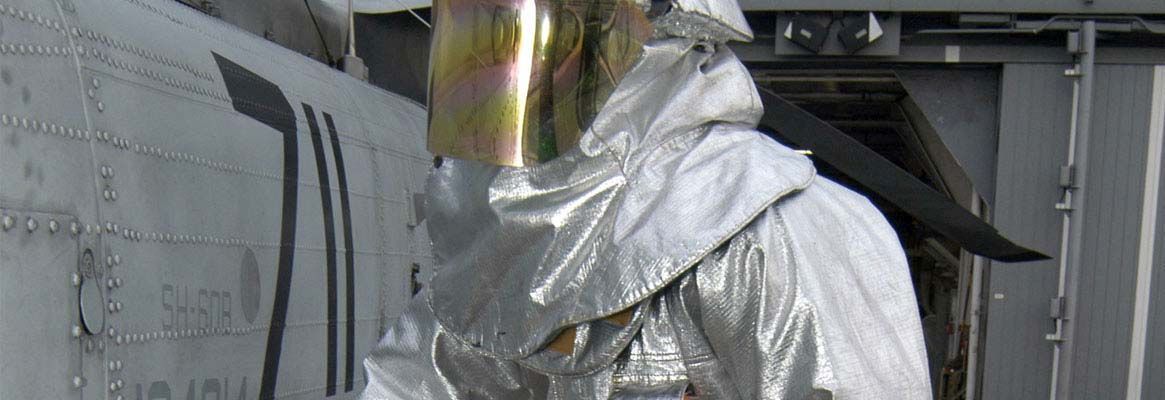Flame retardant fabrics, as the name implies, are used where exposure to fire and risk of accidents are high. Flame retardants help reduce fire damage on people, the environment, and tangible assets. Perhaps its most important function is the safety of humans, now acknowledged as the most important factor in productivity and growth.
What does flame retardant fabrics mean? Flame retardant fabrics are textiles that are naturally more resistant to fire than other material. This is because they have been treated with chemicals or because of a special fireproofing procedure in the manufacture of the fibers. Fire retardant fabrics inhibit, suppress, or delay the production of flames and prevent the spread of fire.
The weight and weave of a fabric can affect its reaction to fire and the speed with which it ignites and burns. Flame retardant fabric is woven tight, which makes it more difficult to burn. Another factor is the design of the fabric surface which also affects flammability. Long, loose, fluffy pile surface fabrics are more likely to burn than hard, tight surface fabrics.
As per a recent survey, the flame retardant fabric market has been valued at US$3.12 billion in 2013. It is anticipated to reach US$4.87 billion by 2020. In terms of volume, the global flame retardant fabrics market stood at 298.2 million square meters in 2013 and is expected to grow by eight per cent in 2014. Government regulations concerning the use of flame retardant garments in industries, especially oil and gas and chemical industries, is driving the global demand for such fabrics.
Globally, flame retardant fabrics are mostly relevant to the defense forces, law enforcement agencies, fire-fighting services, and transport. They are also growing in popularity for home and institutional furnishings. Industrial protective clothing accounted for about 53 per cent of global demand for flame retardant fabric in 2013. The market for such fabric in North America and Europe is well established but Asia Pacific is expected to be the second fastest growing market in the coming years. The region is estimated to experience significant growth in industries such as oil, gas, and chemicals, and is likely to account for a healthy share of the global flame retardant fabrics market by 2020.
Inherent versus coated flame retardant fabric
Typically, coated fabric may be mixed with the base material (additive flame retardants) or chemically bonded to it (reactive flame retardants). Mineral flame retardants are typically additive while organohalogen and organophosphorus compounds can be either reactive or additive. The reaction of the fabric to fire is caused by its chemical reaction.
A flame retardant fabric suitable for use as a flame barrier is made up of a flame durable textile fabric substrate formed of corespun yarns. This yarn comprises a core of flame retardant fiber and a sheath of modacrylic intumescent staple fibers. In normal use, the fabric is flexible and conformable and has good air porosity. When exposed to high temperature or a flame, however, the modacrylic intumescent sheath fiber reacts and swells to form a char which closes the pores or interstices of the fabric to prevent flame or hot gases from passing through.
The journey
Brisk industrialization has brought with it hazards both known and unknown. These, in turn, have turned the focus on safety and made it important to adopt flame retardant fabrics, the need for specialized use of safety equipment and turnout gears whether as work-wear or upholstery or performance fabrics. This has ensured optimum growth so that a vigorous economy keeps pace with safety, providing protection to all at stake, be it workers, machinery, or the environment. It is one of the prime support services needed for rapid growth and modernization and calls for a highly competent and performance-oriented workforce.
Thus, a simple boiler suit has been replaced by specialized flame retardant wear. More and more industries are adopting such fabric. These include welding processes, electric arc applications, and molten metal industries. Flame retardant fabrics have emerged as the most sought-after personal protective gear be it an Anti-G suit for pilots or astronauts and escape suits for human space flight programs.
Testing and certification
Industrial coveralls are tested as per EN 11612 or EN 11611 or the NFPA 2112 whereas BS5867 Part2B&C are certifications for curtains and draperies. Other British standards include BS 5815-1, BS 5856:202 for covers and upholstered seating, and BS 7175, BS 476 for wall hangings.
Effect of washing
An essential point to keep in mind when assessing flame-resistant technology is that inherent flame retardant properties cannot be washed or damaged when exposed to chemicals in the workplace or during laundering, whether at home or commercially. These garments, however, may be damaged by chlorine bleach, the combination of hydrogen peroxide (oxygen bleach) with hard water, or exposure to oxidizing chemicals in the workplace.
Increase in demand has driven the entry of new manufacturers who have joined the flame retardant fabric and fiber majors including E. I. du Pont de Nemours and Company, Milliken & Company, TenCate, PBI Performance Products, Gun Ei Chemical Industry Co, Huntsman Corporation, Kaneka Corporation, Lenzing AG, Solvay S.A., Teijin Aramid BV, and Toyobo.
The road ahead
As the chemical, oil and gas sectors boom, they will drive demand for development of flame retardant fabrics, especially in developing countries which are beginning to adopt safety regulations already in place in developed countries.
Another sector which is poised for growth is the electric arc industry as safety consciousness in this segment increases. Working with live wires is a job hazard in this industry. The transport sector is also anticipated to drive the flame retardant fabrics market in the next few years due to increasing usage of high-performance fabrics in automobile, aircraft, and railways. As awareness grows, so will the demand for safer home and institutional furnishings.
What does flame retardant fabrics mean? Flame retardant fabrics are textiles that are naturally more resistant to fire than other material. This is because they have been treated with chemicals or because of a special fireproofing procedure in the manufacture of the fibers. Fire retardant fabrics inhibit, suppress, or delay the production of flames and prevent the spread of fire.
The weight and weave of a fabric can affect its reaction to fire and the speed with which it ignites and burns. Flame retardant fabric is woven tight, which makes it more difficult to burn. Another factor is the design of the fabric surface which also affects flammability. Long, loose, fluffy pile surface fabrics are more likely to burn than hard, tight surface fabrics.
As per a recent survey, the flame retardant fabric market has been valued at US$3.12 billion in 2013. It is anticipated to reach US$4.87 billion by 2020. In terms of volume, the global flame retardant fabrics market stood at 298.2 million square meters in 2013 and is expected to grow by eight per cent in 2014. Government regulations concerning the use of flame retardant garments in industries, especially oil and gas and chemical industries, is driving the global demand for such fabrics.
Globally, flame retardant fabrics are mostly relevant to the defense forces, law enforcement agencies, fire-fighting services, and transport. They are also growing in popularity for home and institutional furnishings. Industrial protective clothing accounted for about 53 per cent of global demand for flame retardant fabric in 2013. The market for such fabric in North America and Europe is well established but Asia Pacific is expected to be the second fastest growing market in the coming years. The region is estimated to experience significant growth in industries such as oil, gas, and chemicals, and is likely to account for a healthy share of the global flame retardant fabrics market by 2020.
Inherent versus coated flame retardant fabric
Typically, coated fabric may be mixed with the base material (additive flame retardants) or chemically bonded to it (reactive flame retardants). Mineral flame retardants are typically additive while organohalogen and organophosphorus compounds can be either reactive or additive. The reaction of the fabric to fire is caused by its chemical reaction.
A flame retardant fabric suitable for use as a flame barrier is made up of a flame durable textile fabric substrate formed of corespun yarns. This yarn comprises a core of flame retardant fiber and a sheath of modacrylic intumescent staple fibers. In normal use, the fabric is flexible and conformable and has good air porosity. When exposed to high temperature or a flame, however, the modacrylic intumescent sheath fiber reacts and swells to form a char which closes the pores or interstices of the fabric to prevent flame or hot gases from passing through.
The journey
Brisk industrialization has brought with it hazards both known and unknown. These, in turn, have turned the focus on safety and made it important to adopt flame retardant fabrics, the need for specialized use of safety equipment and turnout gears whether as work-wear or upholstery or performance fabrics. This has ensured optimum growth so that a vigorous economy keeps pace with safety, providing protection to all at stake, be it workers, machinery, or the environment. It is one of the prime support services needed for rapid growth and modernization and calls for a highly competent and performance-oriented workforce.
Thus, a simple boiler suit has been replaced by specialized flame retardant wear. More and more industries are adopting such fabric. These include welding processes, electric arc applications, and molten metal industries. Flame retardant fabrics have emerged as the most sought-after personal protective gear be it an Anti-G suit for pilots or astronauts and escape suits for human space flight programs.
Testing and certification
Industrial coveralls are tested as per EN 11612 or EN 11611 or the NFPA 2112 whereas BS5867 Part2B&C are certifications for curtains and draperies. Other British standards include BS 5815-1, BS 5856:202 for covers and upholstered seating, and BS 7175, BS 476 for wall hangings.
Effect of washing
An essential point to keep in mind when assessing flame-resistant technology is that inherent flame retardant properties cannot be washed or damaged when exposed to chemicals in the workplace or during laundering, whether at home or commercially. These garments, however, may be damaged by chlorine bleach, the combination of hydrogen peroxide (oxygen bleach) with hard water, or exposure to oxidizing chemicals in the workplace.
Increase in demand has driven the entry of new manufacturers who have joined the flame retardant fabric and fiber majors including E. I. du Pont de Nemours and Company, Milliken & Company, TenCate, PBI Performance Products, Gun Ei Chemical Industry Co, Huntsman Corporation, Kaneka Corporation, Lenzing AG, Solvay S.A., Teijin Aramid BV, and Toyobo.
The road ahead
As the chemical, oil and gas sectors boom, they will drive demand for development of flame retardant fabrics, especially in developing countries which are beginning to adopt safety regulations already in place in developed countries.
Another sector which is poised for growth is the electric arc industry as safety consciousness in this segment increases. Working with live wires is a job hazard in this industry. The transport sector is also anticipated to drive the flame retardant fabrics market in the next few years due to increasing usage of high-performance fabrics in automobile, aircraft, and railways. As awareness grows, so will the demand for safer home and institutional furnishings.
About the author:
Sushil Behl, Director, Sure Safety (India) Pvt. Ltd (Projects and International Sales) holds a Masters in Management with PG qualifications in Materials, Finance and HR. He heads the Research and Development Department and also the Exports Division of Sure Safety (India) Pvt Ltd. (SSIPL) who are the manufacturers of High end PPEs. He has been with SSIPL since its initiation and has played an instrumental role in its growth and achievements.








